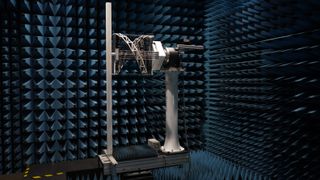Breakthrough coming? Iceland could get solar power from space in 2030
The space-based solar power demonstration aspires to be the world's first.

British startup plans to supply solar power from space to Icelanders by 2030, in what could be the world's first demonstration of this novel renewable energy source.
The space solar power project, announced on Monday (Oct. 21), is a partnership between U.K.-based Space Solar, Reykjavik Energy and Icelandic sustainability initiative Transition Labs.
It intends to launch a demonstrator satellite by 2030, which will beam to Earth 30 megawatts of clean energy — enough to power about 3,000 homes.
The power-beaming satellite will weigh 70.5 tons (64 metric tons), be about 1,312 feet (400 meters) wide (including its solar arrays) and circle the planet in medium Earth orbit, a near-space region at altitudes between 1,241 miles and 22,000 miles (2,000 and 36,000 kilometers).
Related: Can space-based solar power really work? Here are the pros and cons.
By 2036, the partners want to build a fleet of six such space-based solar power stations, capable of supplying gigawatts of clean electricity to users on Earth 24/7 regardless of weather. By the mid-2040s, Space Solar's orbiting power plants could be delivering over 15 gigawatts of energy.
Space Solar said the development and manufacturing of the pilot plant will cost $800 million. The system will provide electricity at about one-quarter the cost of nuclear power, at $2.25 billion per gigawatt, the company added, making it competitive with Earth-based renewable sources. Unlike photovoltaics and wind turbines on Earth's surface, the orbiting power stations will not suffer from intermittency — a major drawback of conventional renewable power generation. They will produce electricity constantly, regardless of the time of day or weather conditions.
Get the Space.com Newsletter
Breaking space news, the latest updates on rocket launches, skywatching events and more!
"Space-based solar power offers unparalleled benefits with competitive energy costs and 24/7 availability,' Martin Soltau, Space Solar's co-CEO, said in an emailed statement. "Reykjavik Energy's recognition of the potential for space-based solar to drive the energy transition is exciting, and we're thrilled to be working together in partnership toward a sustainable future."
Each of the 30-megawatt solar farms will be delivered to orbit by a single launch of SpaceX's Starship megarocket, Space Solar envisions.
With a capacity to lift up to 165 tons (150 metric tons) of payload into low Earth orbit, Starship is poised to revolutionize humankind's use of space by driving down launch cost, the major hurdle for the deployment of large-scale space infrastructure such as orbiting solar power stations.
The project partners are currently scouting for locations to build ground-based receiving antennas that would collect the energy beamed down in the form of high-frequency radio waves and convert it into electricity to be fed into the power grid.
Space Solar's power plants are built from modular core building blocks that could be assembled to create solar power harvesters of different sizes. The giant satellites can orbit at different altitudes and provide power to multiple countries at the same time, the company said.
Until recently, space-based solar power was considered utter science fiction due to the enormous sizes required to produce usable amounts of power and the high cost of launching such vast assemblies into space. The arrival of SpaceX's Starship and advances in space robotics, however, have brought the dream closer to reality.
A number of countries, including Japan and China, plan to launch space-based solar power demonstrators in the coming years and develop fully fledged orbiting power stations within the next two decades. In February, U.S. startup Virtus Solis announced plans to launch a space-based solar power demonstrator in 2027. That project, too, will rely on SpaceX's Starship to get off the ground, and will provide about 1 megawatt to users on Earth.
Join our Space Forums to keep talking space on the latest missions, night sky and more! And if you have a news tip, correction or comment, let us know at: community@space.com.

Tereza is a London-based science and technology journalist, aspiring fiction writer and amateur gymnast. Originally from Prague, the Czech Republic, she spent the first seven years of her career working as a reporter, script-writer and presenter for various TV programmes of the Czech Public Service Television. She later took a career break to pursue further education and added a Master's in Science from the International Space University, France, to her Bachelor's in Journalism and Master's in Cultural Anthropology from Prague's Charles University. She worked as a reporter at the Engineering and Technology magazine, freelanced for a range of publications including Live Science, Space.com, Professional Engineering, Via Satellite and Space News and served as a maternity cover science editor at the European Space Agency.
-
Abe53 Why the complexity?Reply
Just put a huge focusing mirror at geo-synchrous orbit and reflect sunlight onto an existing solar array. There will be no night in the immediate area but many such arrays are in sparsely inhabited areas, so not much downside. -
Meteoric Marmot There are several downsides over the beamed microwave approach:Reply
1. Clouds block visible light but not microwaves
2. Solar panels are ~20% efficient so you'd need to beam down 5 times the sunlight you need, 80% of which will end up heating the area and contributing to climate change.
3. The extra "daylight" will confuse animals leading to population reductions -
Classical Motion This would add more light and heat than normal to the planet. Don’t do it. Iceland has geothermal. Use it.Reply
This is why people doubt climate policy. They have free super heated water.
We all do.
If the earth is warming, the last thing you would do is beam more energy from space.
Instead of all this expense, and inefficiency and special materials, why not drill some holes for that water.